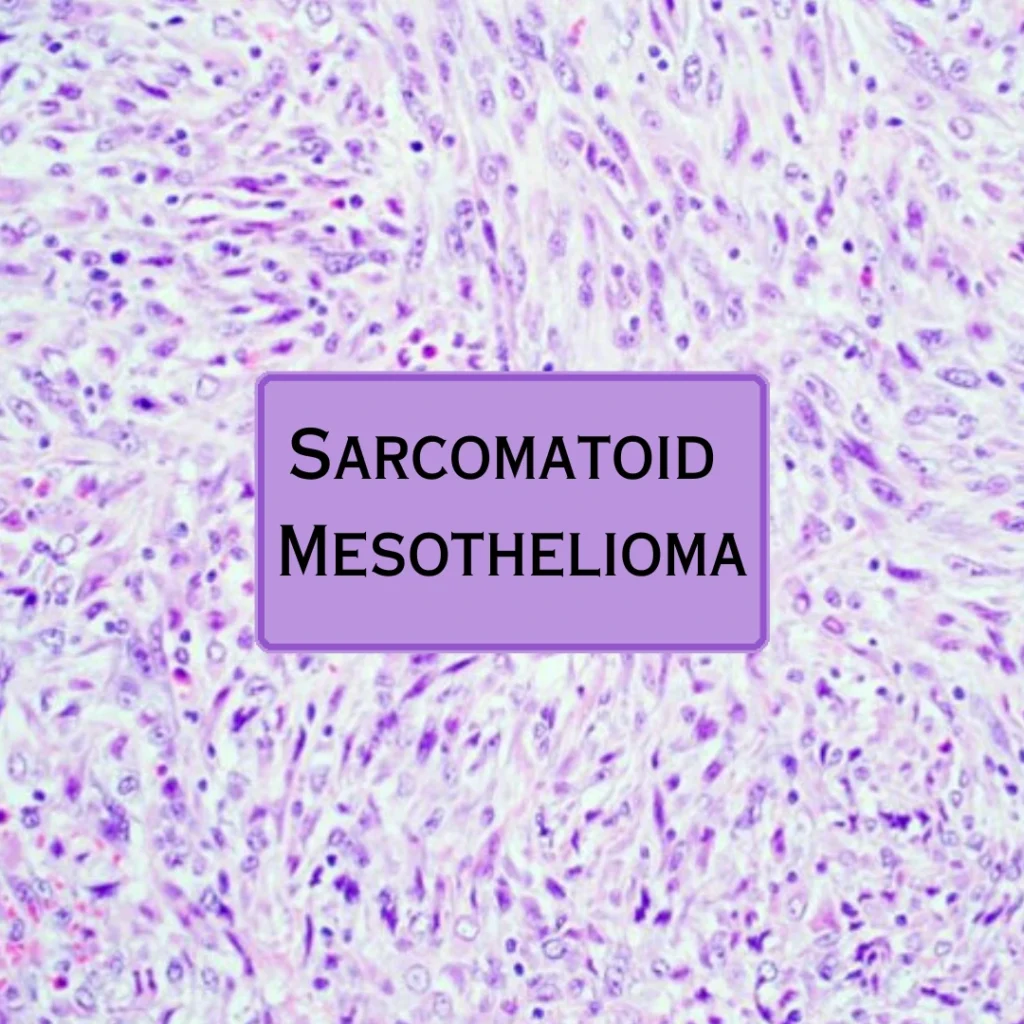Key takeaways: Sarcomatoid mesothelioma is the rarest and most aggressive origination of
mesothelioma. These cells are irregular in shape, size, and growth, and they are more likely to
metastasize beyond their site of origin into other parts of the body. Most patients with
this type of mesothelioma opt for palliative treatment plans, as current diagnostic techniques
usually detect this diagnosis too late for surgery or chemotherapy interventions to work
effectively. The average prognosis is approximately eight and a half months after initial diagnosis.

Sarcomatoid Mesothelioma
This type of mesothelioma is the rarest cell origin in mesothelioma cases, accounting for about
10-20% of all manifestations. Sarcomatoid cells are also present in biphasic mesothelioma, as at
least 10% of biphasic cells need to be both sarcomatoid and epithelioid. Biphasic mesothelioma
that has a larger constituency of sarcomatoid cells is notoriously more difficult to treat; this is
because sarcomatoid cells grow relatively quickly and irregularly. Sarcomatoid
mesothelioma has the worst prognosis of the three mesothelioma cell types: average life
expectancy after diagnosis is less than a year, around eight and a half months.
Here are some key distinguishing factors between sarcomatoid mesothelioma and the other types
of mesothelioma we’ve covered:
- Sarcomatoid cells themselves are irregularly shaped; they are elongated and
spindle-shaped. They have long nuclei, in which there are usually more than one in a
single cell. - The growth patterns of sarcomatoid cells lend themselves to metastasis. Unlike biphasic
and epithelioid mesothelioma, in which cancerous cells grow in clusters, sarcomatoid
cells migrate quickly to other parts of the body. - Sarcomatoid mesothelioma is difficult to treat. Again, because of the growth patterns of
the cells, they’re often spread out beyond a single area. - Along with being the rarest form of mesothelioma, it’s also the most aggressive. The
potential for metastasis, unchecked growth, and irregular shape contribute to this
“aggression.” - This type of mesothelioma is known to be associated with previous exposure to asbestos.
- Most sarcomatoid mesothelioma occurs in the pleura, or the tissues surrounding the
lungs. This cell type is much rarer in other common mesothelioma sites, like the tissues
around the abdomen or heart. - There are different histographic “subtypes” of sarcomatoid mesothelioma, which makes
diagnosis somewhat difficult. - Mesothelioma can only be diagnosed as specifically a sarcomatoid origination if patients
undergo a historiographic and cryptographic biopsy. This means that a sample of living
tissue is extracted from the mesothelioma site and sent to a lab for further testing, and
then researchers can confirm that the mesothelioma has a sarcomatoid origin. If a patient
is physically fit enough to receive a biopsy-based diagnosis, they should opt for it: it
facilitates a more contextual treatment plan by detailing the progression, growth patterns,
and metastatic tendencies of the cells of the cancer.
Treatment Options
Because it is the most aggressive type of mesothelioma, most patients
and providers opt for palliative care. If the cancer is caught especially early, and doctors
determine that it’s resectable, or able to be removed by surgery, then patients might undergo the
surgical route. Alternatively, some patients and doctors opt for chemotherapy or radiotherapy
treatments in order to shrink tumor size or alleviate pain associated with tumor growth. Usually,
though, these procedures fall under the umbrella term of “palliative care” because they seek to
provide patients comfort, not to cure or remove the cancer. Hopefully, more accurate and speedy
diagnostic techniques allow doctors to diagnose sarcomatoid mesothelioma more quickly, thus
increasing patient prognosis and treatment options.
If you or a loved one has been diagnosed with an asbestos-related disease, please call
(800)-505-6000 for legal help. For more information, fill out the form on our Contact Us page.
Sources:
Calthorpe, L., Romero-Hernandez, F., Miller, P., Conroy, P. C., Hirose, K., Kim, A.,
Kirkwood, K., Nakakura, E., Corvera, C., Maker, A. V., Alseidi, A., & Adam, M. A.
(2023). Contemporary Trends in Malignant Peritoneal Mesothelioma: Incidence and
Survival in the United States. Cancers, 15(1), Article 1.
https://doi.org/10.3390/cancers15010229
Galetta, D., Catino, A., Misino, A., Logroscino, A., & Fico, M. (2016). Sarcomatoid
mesothelioma: Future advances in diagnosis, biomolecular assessment, and therapeutic
options in a poor-outcome disease. Tumori, 102(2), 127–130.
https://doi.org/10.5301/tj.5000364
Klebe, S., Brownlee, N. A., Mahar, A., Burchette, J. L., Sporn, T. A., Vollmer, R. T., &
Roggli, V. L. (2010). Sarcomatoid mesothelioma: A clinical–pathologic correlation of
326 cases. Modern Pathology, 23(3), 470–479.
https://doi.org/10.1038/modpathol.2009.180